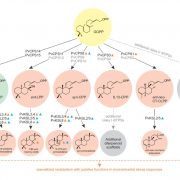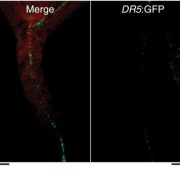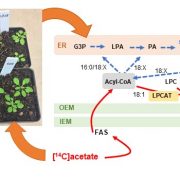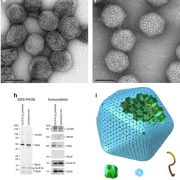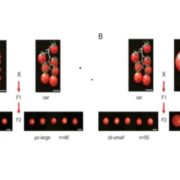Drugs Triggering Oil Accumulation in a Diatom
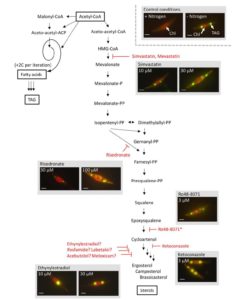 Oils composed of triacylglycerols (TAGs) have a broad range of applications, ranging from foods to biofuels. Microalgae are promising feedstocks for the production of (TAGs) but obtaining high yields of TAGs is challenging. Conte et al. (10.1104/pp.17.01804) have developed a phenotypic assay for the accumulation of oil droplets in the diatom Phaeodactylum tricornutum. They have used this assay to screen a library of 1,200 drugs for their ability to trigger TAG accumulation in this alga. As a result, they have identified 34 molecules that act in a dose-dependent manner to increase TAG accumulation. The previously characterized targets of these compounds include cell division and cell signaling effectors, membrane receptors and transporters, and sterol metabolism. Among the five compounds likely to be acting on sterol metabolism, the authors focused on ethynylestradiol, a synthetic form of estrogen that is used in contraceptive pills and known for its ecological impact as an endocrine disruptor. Ethynylestradiol impaired the production of very-long-chain polyunsaturated fatty acids and triggered the recycling of fatty acids from membrane lipids to TAG. The P. tricornutum transcriptomic response to treatment with ethynylestradiol was consistent with the reallocation of carbon from sterols to acetyl-coenzyme A and TAG. This phenotypic screen opens new perspectives for the exploration of novel bioactive molecules, potential target genes, and pathways controlling TAG biosynthesis. It also unraveled the sensitivity of diatoms to endocrine disruptors, highlighting an impact of anthropogenic pollution on phytoplankton.
Oils composed of triacylglycerols (TAGs) have a broad range of applications, ranging from foods to biofuels. Microalgae are promising feedstocks for the production of (TAGs) but obtaining high yields of TAGs is challenging. Conte et al. (10.1104/pp.17.01804) have developed a phenotypic assay for the accumulation of oil droplets in the diatom Phaeodactylum tricornutum. They have used this assay to screen a library of 1,200 drugs for their ability to trigger TAG accumulation in this alga. As a result, they have identified 34 molecules that act in a dose-dependent manner to increase TAG accumulation. The previously characterized targets of these compounds include cell division and cell signaling effectors, membrane receptors and transporters, and sterol metabolism. Among the five compounds likely to be acting on sterol metabolism, the authors focused on ethynylestradiol, a synthetic form of estrogen that is used in contraceptive pills and known for its ecological impact as an endocrine disruptor. Ethynylestradiol impaired the production of very-long-chain polyunsaturated fatty acids and triggered the recycling of fatty acids from membrane lipids to TAG. The P. tricornutum transcriptomic response to treatment with ethynylestradiol was consistent with the reallocation of carbon from sterols to acetyl-coenzyme A and TAG. This phenotypic screen opens new perspectives for the exploration of novel bioactive molecules, potential target genes, and pathways controlling TAG biosynthesis. It also unraveled the sensitivity of diatoms to endocrine disruptors, highlighting an impact of anthropogenic pollution on phytoplankton.


